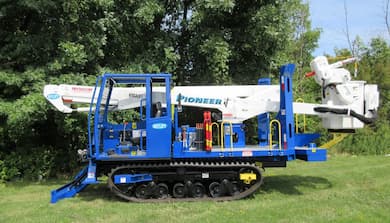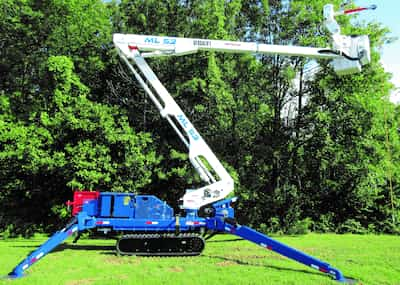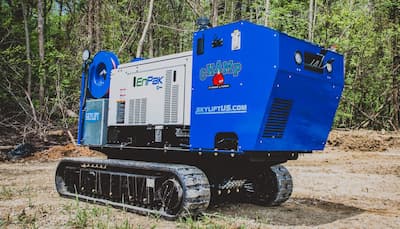Not every job site is easily accessible. When utility crews face muddy terrain, off-grid locations or tight spaces, standard bucket trucks and wheeled utility vehicles can struggle to get the job done. That’s where tracked utility vehicles come in.
At Skylift, we specialize in tracked backyard utility vehicles built for tough job sites. Machines like the ML 47, ML 55, the Patriot and the Pioneer provide unmatched access to hard-to-reach areas, making them essential tools for utility maintenance, power line work and other demanding applications.
In this article, we’ll explore when and why you should choose a tracked utility vehicle over a standard wheeled option.
When Standard Utility Trucks Won’t Cut It
Utility bucket trucks are a great solution when roads and stable ground provide easy access to job sites. But as soon as conditions get rough – mud, snow, steep inclines or off-road terrain – their four-wheel design becomes a liability rather than an asset.
Wheeled utility trucks have concentrated weight on four tires, which can make them prone to:
- Sinking in soft or muddy ground: Heavy equipment puts pressure on a small surface area, causing wheels to dig in and get stuck.
- Struggling in off-road conditions: When there’s no road or a job site in remote areas, a standard truck may lose traction or struggle in rough terrain.
Top Situations Where Tracked Utility Vehicles Are Essential
1. Muddy, Wet or Soft Terrain
One of the biggest advantages of tracked utility vehicles is their ability to navigate soft, unstable ground where wheeled vehicles would sink. Mud, snow, sand and flood-prone areas create challenges for traditional bucket trucks because their heavy weight is concentrated on four wheels, increasing ground pressure and causing them to become stuck.
Tracked utility vehicles distribute weight more evenly across a larger surface area, significantly reducing ground pressure. This allows them to glide over soft terrain without sinking, making them ideal for:
- Storm recovery work: After hurricanes, heavy rainfall or snowstorms, roads can be flooded or covered in debris. Tracked vehicles allow utility crews to access damaged power lines and restore service quickly.
- Flood-prone areas: Swampy or waterlogged environments are difficult for wheeled vehicles, but tracked machines can traverse wet conditions with ease.
2. Remote, Off-Grid Job Sites
Not all utility work happens near paved roads. In rural areas, forests and remote job sites, crews often need to reach power lines and infrastructure where no road access exists. Standard bucket trucks rely on well-maintained roads, but when the job site is miles off the beaten path, tracked utility vehicles become the only viable option.
Tracked machines excel in these conditions because they can travel over rough, undeveloped terrain. For instance, both the Patriot digger derrick and the Pioneer bucket lift offer ride-on capabilities, which makes it easy to navigate to more remote locations.
3. Uneven or Steep Terrain
For crews working in mountainous regions, hilly job sites or areas with unstable ground, a tracked utility vehicle provides the stability and control needed to work safely and efficiently. Traditional bucket trucks, with their high center of gravity and four-wheel design, can struggle on sloped or uneven ground, increasing the risk of tipping or getting stuck. Tracked utility vehicles, on the other hand, are built for these conditions.
Tracked utility vehicles provide greater stability and climbing capability by distributing weight evenly across a larger surface area, which helps keep the machine balanced and reduces the risk of sinking or tipping. Unlike wheels that can slip or lose grip on loose soil or gravel, tracks maintain continuous contact with the ground, improving control and stability on inclines.
4. Tight Spaces & Minimal Ground Disturbance
Some job sites may not have rough terrain, but they do have tight access points and delicate landscaping. When you need to navigate into backyards or alleyways, a full-size bucket truck often can’t get close enough to the work area. More than that, these areas also often have delicate landscaping and features that workers may need to move around and avoid disturbing.
When you have tight access points and delicate surfaces, tracked backyard easement machines are the perfect solution. For instance, machines like the ML 55 and the MD 6000 can:
- Pass through standard 36-inch gates
- Work under 7-foot eaves
- Reduce soil compaction and rutting when compared to wheeled equipment
For tight-access job sites where minimizing ground disturbance is a priority, tracked utility vehicles provide the perfect balance of mobility, power and environmental protection.
Choosing the Right Equipment for Your Next Job
Tracked utility vehicles are not always better than utility bucket trucks, but they are a necessity when conditions demand better traction, stability and access. At Skylift, we build industry-leading easement equipment that keeps crews working efficiently, no matter their circumstances. If you’re interested in learning more about what the right equipment may be for you, reach out and contact us today!


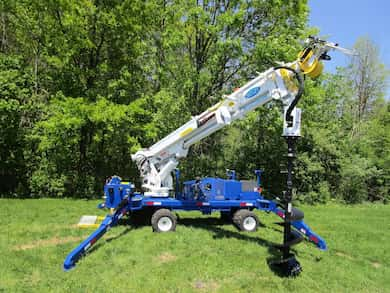
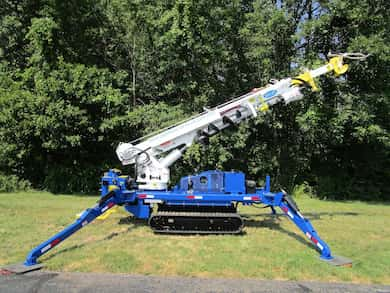
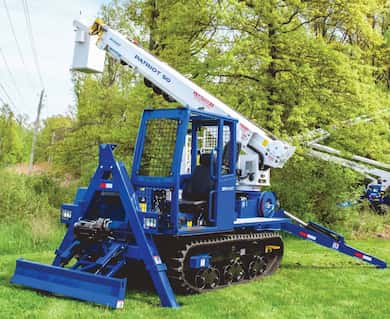

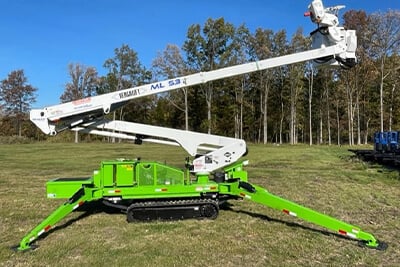
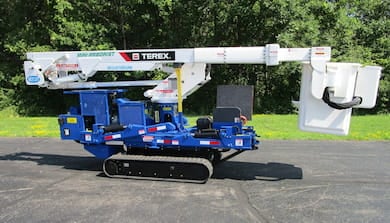

-2.jpg)
